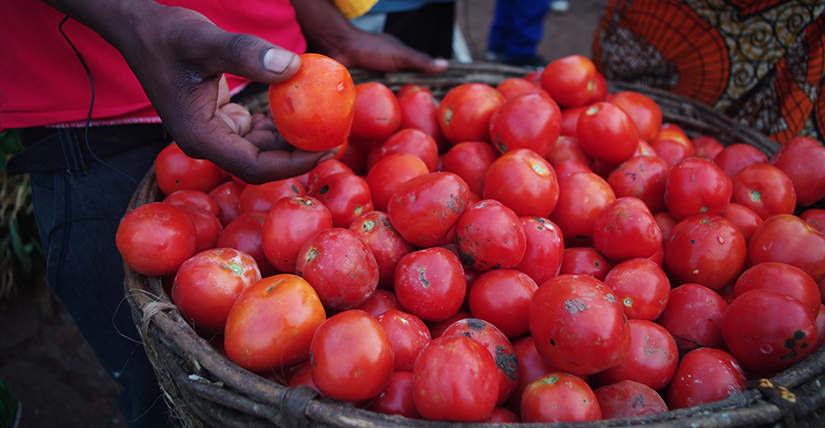
Editor’s note: This blog post by Gurbinder Singh Gill was originally a presentation given at the Horticulture Innovation Lab’s 2017 annual meeting.
Gill manages the Horticulture Innovation Lab’s project focused on reducing postharvest losses in Rwanda as the managing associate at Agribusiness Associates, Inc.

Postharvest losses in African agriculture are often estimated at about 30-40 percent. The Horticulture Innovation Lab’s latest project in Rwanda set out to reduce postharvest losses in horticulture last year. Our first step was to conduct in-depth field work to understand the main causes and stages at which postharvest losses occurred in our four focus crops — tomatoes, green chilies, green bananas and orange fleshed sweet potatoes. We set out to understand the issues from three perspectives:
- Crops — We used a commodity systems assessment methodology to track the produce from the farm to retail. We paid attention to how the crop was harvested, packed and transported to understand where and why losses occurred.
- Relationships and Power Dynamics — We conducted value chain analysis to understand the relationships between all the stakeholders in the value chain and their context, to understand where opportunities for partnerships exist.
- Environment — We measured the environmental footprint of agricultural practices by quantifying wasted resources including water, fertilizers, and energy. The analysis identifies environmental hotspots within the value chain that represent key leverage points to reduce environmental impact.
These are our key lessons, distilled from the studies on the four focus crops:
- Horticultural industry in Rwanda is developing
The horticultural industry in Rwanda has been growing in the last decade. Most farmers have small plots of land (less than 0.33 hectares, IFAD 2016). Farmers are facing many challenges including low yields, lack of good agricultural practices, poor postharvest practices, lack of big buyers, high transportation costs, low processing and value addition options, and price fluctuations. Growers and processors are operating in their own silos and there is a lack of trust.
- Lack of lead actors across value chains
All four of the crops we studied are characterized by the absence of lead actors in the value chain, especially processors. For processors, a consistent supply in terms of volume and quality is crucial for successful operations. However, farmers and processors are caught in a chicken/egg scenario, where processors cannot be successful without steady supply, and farmers cannot risk producing sufficient volumes until they know they have a guaranteed market. This is especially true for green chilies and orange fleshed sweet potatoes where the local fresh market is small.

- High postharvest losses due to defects, decay and mechanical damage
Postharvest losses are heavy starting from the farm to retail. For tomatoes, we observed that on average 21 percent was discarded at the farm level, 11.5 percent was discarded at the collection point, 10 percent was discarded at the wholesale market and 13.6 percent was discarded at the retail market. This is a total postharvest loss of 56 percent! At the farm level, there is no spacing between plants for pickers to walk — hence tomatoes end up being trampled on during harvest. The tomatoes are picked in plastic basins and get squashed when basins are piled one on top of the other. From the field to the collection point, tomatoes are put in woven baskets weighing approximately 100 kgs. The baskets are too large and all the tomatoes touching the rough wall of the basket get bruised and pricked. There is also no infrastructure for cooling, so the tomatoes decay and have a shorter shelf life.
- Postharvest loss reduction has positive effects on the environment
We conducted a life cycle assessment (LCA) to quantify the losses or wasted resources such as water, fertilizer, and energy from postharvest losses. The LCA also quantifies how wasted fertilizer and resources, impact the environment. Degraded environments lead to lower yields and impact population health adversely.
In tomatoes, our study shows that a 20 percent reduction in postharvest losses would save per hectare 100 kg of synthetic fertilizer/hectare and 4 metric tons of organic fertilizer. A 20 percent reduction in losses would also save up to 30 metric tons of water, per ton of tomato harvested. Reducing postharvest losses reduces sedimentation and nutrient loading in water ways, as well.

- Capacity building and low-cost solutions are required in handling and packing across the value chain
Farmers need capacity building in handling tomatoes such as when to pick tomatoes and how to use shade for harvested tomatoes to reduce decay from heat. It was observed that tomatoes are handled up to 27 times before transportation to the wholesale market. Low cost solutions, such as using plastic crates instead of large woven baskets very quickly pay for themselves and reduce damage to tomatoes as well as allow for ventilation.
- Building entrepreneurship across the value chain is critical
Building entrepreneurship in processing and storage solutions including cold storage is critical for reducing postharvest losses. Guiding the growth of pioneers is also important — for example, the green chilies value chain currently has only one exporter. Entrepreneurs that tap into new markets or unfulfilled market demand can prove to be steady buyers for farmers and can help upgrade the entire value chain.
Led by Agribusiness Associates in partnership with Rwanda’s Ministry of Agriculture and Natural Resources, the Postharvest Education Foundation, Rwanda Agriculture Board and University of Rwanda, this project is supported by the Horticulture Innovation Lab with funding from the U.S. Agency for International Development as part of the U.S. government’s global Feed the Future initiative.
More information:
- Project information: Reducing postharvest losses in Rwanda
- More 5-Minute Lesson blog posts
